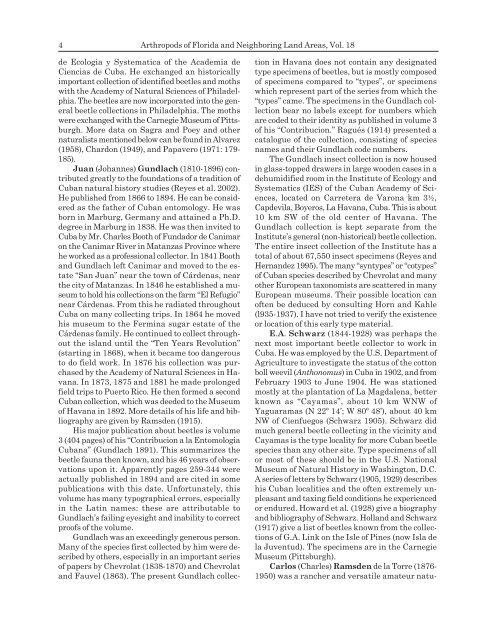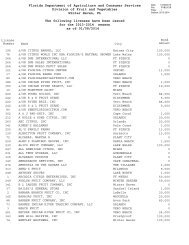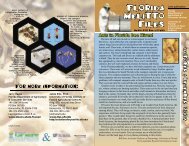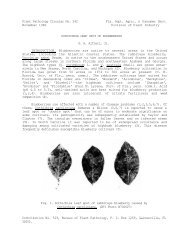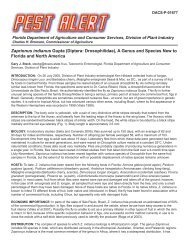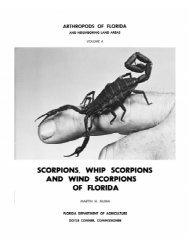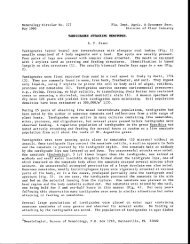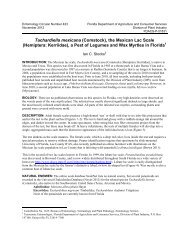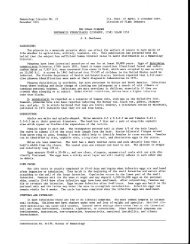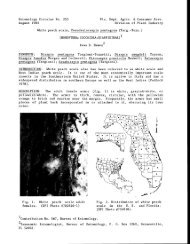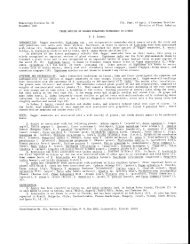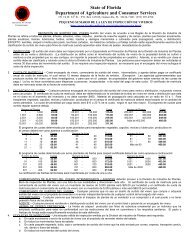A Checklist of the Beetles of Cuba with Data on Distributions and ...
A Checklist of the Beetles of Cuba with Data on Distributions and ...
A Checklist of the Beetles of Cuba with Data on Distributions and ...
You also want an ePaper? Increase the reach of your titles
YUMPU automatically turns print PDFs into web optimized ePapers that Google loves.
4<br />
Arthropods <str<strong>on</strong>g>of</str<strong>on</strong>g> Florida <strong>and</strong> Neighboring L<strong>and</strong> Areas, Vol. 18<br />
de Ecologia y Systematica <str<strong>on</strong>g>of</str<strong>on</strong>g> <str<strong>on</strong>g>the</str<strong>on</strong>g> Academia de<br />
Ciencias de <str<strong>on</strong>g>Cuba</str<strong>on</strong>g>. He exchanged an historically<br />
important collecti<strong>on</strong> <str<strong>on</strong>g>of</str<strong>on</strong>g> identified beetles <strong>and</strong> moths<br />
<str<strong>on</strong>g>with</str<strong>on</strong>g> <str<strong>on</strong>g>the</str<strong>on</strong>g> Academy <str<strong>on</strong>g>of</str<strong>on</strong>g> Natural Sciences <str<strong>on</strong>g>of</str<strong>on</strong>g> Philadelphia.<br />
The beetles are now incorporated into <str<strong>on</strong>g>the</str<strong>on</strong>g> general<br />
beetle collecti<strong>on</strong>s in Philadelphia. The moths<br />
were exchanged <str<strong>on</strong>g>with</str<strong>on</strong>g> <str<strong>on</strong>g>the</str<strong>on</strong>g> Carnegie Museum <str<strong>on</strong>g>of</str<strong>on</strong>g> Pittsburgh.<br />
More data <strong>on</strong> Sagra <strong>and</strong> Poey <strong>and</strong> o<str<strong>on</strong>g>the</str<strong>on</strong>g>r<br />
naturalists menti<strong>on</strong>ed below can be found in Alvarez<br />
(1958), Chard<strong>on</strong> (1949), <strong>and</strong> Papavero (1971: 179-<br />
185).<br />
Juan (Johannes) Gundlach (1810-1896) c<strong>on</strong>tributed<br />
greatly to <str<strong>on</strong>g>the</str<strong>on</strong>g> foundati<strong>on</strong>s <str<strong>on</strong>g>of</str<strong>on</strong>g> a traditi<strong>on</strong> <str<strong>on</strong>g>of</str<strong>on</strong>g><br />
<str<strong>on</strong>g>Cuba</str<strong>on</strong>g>n natural history studies (Reyes et al. 2002).<br />
He published from 1866 to 1894. He can be c<strong>on</strong>sidered<br />
as <str<strong>on</strong>g>the</str<strong>on</strong>g> fa<str<strong>on</strong>g>the</str<strong>on</strong>g>r <str<strong>on</strong>g>of</str<strong>on</strong>g> <str<strong>on</strong>g>Cuba</str<strong>on</strong>g>n entomology. He was<br />
born in Marburg, Germany <strong>and</strong> attained a Ph.D.<br />
degree in Marburg in 1838. He was <str<strong>on</strong>g>the</str<strong>on</strong>g>n invited to<br />
<str<strong>on</strong>g>Cuba</str<strong>on</strong>g> by Mr. Charles Booth <str<strong>on</strong>g>of</str<strong>on</strong>g> Fundador de Canimar<br />
<strong>on</strong> <str<strong>on</strong>g>the</str<strong>on</strong>g> Canimar River in Matanzas Province where<br />
he worked as a pr<str<strong>on</strong>g>of</str<strong>on</strong>g>essi<strong>on</strong>al collector. In 1841 Booth<br />
<strong>and</strong> Gundlach left Canimar <strong>and</strong> moved to <str<strong>on</strong>g>the</str<strong>on</strong>g> estate<br />
“San Juan” near <str<strong>on</strong>g>the</str<strong>on</strong>g> town <str<strong>on</strong>g>of</str<strong>on</strong>g> Cárdenas, near<br />
<str<strong>on</strong>g>the</str<strong>on</strong>g> city <str<strong>on</strong>g>of</str<strong>on</strong>g> Matanzas. In 1846 he established a museum<br />
to hold his collecti<strong>on</strong>s <strong>on</strong> <str<strong>on</strong>g>the</str<strong>on</strong>g> farm “El Refugio”<br />
near Cárdenas. From this he radiated throughout<br />
<str<strong>on</strong>g>Cuba</str<strong>on</strong>g> <strong>on</strong> many collecting trips. In 1864 he moved<br />
his museum to <str<strong>on</strong>g>the</str<strong>on</strong>g> Fermina sugar estate <str<strong>on</strong>g>of</str<strong>on</strong>g> <str<strong>on</strong>g>the</str<strong>on</strong>g><br />
Cárdenas family. He c<strong>on</strong>tinued to collect throughout<br />
<str<strong>on</strong>g>the</str<strong>on</strong>g> isl<strong>and</strong> until <str<strong>on</strong>g>the</str<strong>on</strong>g> “Ten Years Revoluti<strong>on</strong>”<br />
(starting in 1868), when it became too dangerous<br />
to do field work. In 1876 his collecti<strong>on</strong> was purchased<br />
by <str<strong>on</strong>g>the</str<strong>on</strong>g> Academy <str<strong>on</strong>g>of</str<strong>on</strong>g> Natural Sciences in Havana.<br />
In 1873, 1875 <strong>and</strong> 1881 he made prol<strong>on</strong>ged<br />
field trips to Puerto Rico. He <str<strong>on</strong>g>the</str<strong>on</strong>g>n formed a sec<strong>on</strong>d<br />
<str<strong>on</strong>g>Cuba</str<strong>on</strong>g>n collecti<strong>on</strong>, which was deeded to <str<strong>on</strong>g>the</str<strong>on</strong>g> Museum<br />
<str<strong>on</strong>g>of</str<strong>on</strong>g> Havana in 1892. More details <str<strong>on</strong>g>of</str<strong>on</strong>g> his life <strong>and</strong> bibliography<br />
are given by Ramsden (1915).<br />
His major publicati<strong>on</strong> about beetles is volume<br />
3 (404 pages) <str<strong>on</strong>g>of</str<strong>on</strong>g> his “C<strong>on</strong>tribuci<strong>on</strong> a la Entomologia<br />
<str<strong>on</strong>g>Cuba</str<strong>on</strong>g>na” (Gundlach 1891). This summarizes <str<strong>on</strong>g>the</str<strong>on</strong>g><br />
beetle fauna <str<strong>on</strong>g>the</str<strong>on</strong>g>n known, <strong>and</strong> his 46 years <str<strong>on</strong>g>of</str<strong>on</strong>g> observati<strong>on</strong>s<br />
up<strong>on</strong> it. Apparently pages 259-344 were<br />
actually published in 1894 <strong>and</strong> are cited in some<br />
publicati<strong>on</strong>s <str<strong>on</strong>g>with</str<strong>on</strong>g> this date. Unfortunately, this<br />
volume has many typographical errors, especially<br />
in <str<strong>on</strong>g>the</str<strong>on</strong>g> Latin names: <str<strong>on</strong>g>the</str<strong>on</strong>g>se are attributable to<br />
Gundlach’s failing eyesight <strong>and</strong> inability to correct<br />
pro<str<strong>on</strong>g>of</str<strong>on</strong>g>s <str<strong>on</strong>g>of</str<strong>on</strong>g> <str<strong>on</strong>g>the</str<strong>on</strong>g> volume.<br />
Gundlach was an exceedingly generous pers<strong>on</strong>.<br />
Many <str<strong>on</strong>g>of</str<strong>on</strong>g> <str<strong>on</strong>g>the</str<strong>on</strong>g> species first collected by him were described<br />
by o<str<strong>on</strong>g>the</str<strong>on</strong>g>rs, especially in an important series<br />
<str<strong>on</strong>g>of</str<strong>on</strong>g> papers by Chevrolat (1838-1870) <strong>and</strong> Chevrolat<br />
<strong>and</strong> Fauvel (1863). The present Gundlach collec-<br />
ti<strong>on</strong> in Havana does not c<strong>on</strong>tain any designated<br />
type specimens <str<strong>on</strong>g>of</str<strong>on</strong>g> beetles, but is mostly composed<br />
<str<strong>on</strong>g>of</str<strong>on</strong>g> specimens compared to “types”, or specimens<br />
which represent part <str<strong>on</strong>g>of</str<strong>on</strong>g> <str<strong>on</strong>g>the</str<strong>on</strong>g> series from which <str<strong>on</strong>g>the</str<strong>on</strong>g><br />
“types” came. The specimens in <str<strong>on</strong>g>the</str<strong>on</strong>g> Gundlach collecti<strong>on</strong><br />
bear no labels except for numbers which<br />
are coded to <str<strong>on</strong>g>the</str<strong>on</strong>g>ir identity as published in volume 3<br />
<str<strong>on</strong>g>of</str<strong>on</strong>g> his “C<strong>on</strong>tribuci<strong>on</strong>.” Ragués (1914) presented a<br />
catalogue <str<strong>on</strong>g>of</str<strong>on</strong>g> <str<strong>on</strong>g>the</str<strong>on</strong>g> collecti<strong>on</strong>, c<strong>on</strong>sisting <str<strong>on</strong>g>of</str<strong>on</strong>g> species<br />
names <strong>and</strong> <str<strong>on</strong>g>the</str<strong>on</strong>g>ir Gundlach code numbers.<br />
The Gundlach insect collecti<strong>on</strong> is now housed<br />
in glass-topped drawers in large wooden cases in a<br />
dehumidified room in <str<strong>on</strong>g>the</str<strong>on</strong>g> Institute <str<strong>on</strong>g>of</str<strong>on</strong>g> Ecology <strong>and</strong><br />
Systematics (IES) <str<strong>on</strong>g>of</str<strong>on</strong>g> <str<strong>on</strong>g>the</str<strong>on</strong>g> <str<strong>on</strong>g>Cuba</str<strong>on</strong>g>n Academy <str<strong>on</strong>g>of</str<strong>on</strong>g> Sciences,<br />
located <strong>on</strong> Carretera de Var<strong>on</strong>a km 3½,<br />
Capdevila, Boyeros, La Havana, <str<strong>on</strong>g>Cuba</str<strong>on</strong>g>. This is about<br />
10 km SW <str<strong>on</strong>g>of</str<strong>on</strong>g> <str<strong>on</strong>g>the</str<strong>on</strong>g> old center <str<strong>on</strong>g>of</str<strong>on</strong>g> Havana. The<br />
Gundlach collecti<strong>on</strong> is kept separate from <str<strong>on</strong>g>the</str<strong>on</strong>g><br />
Institute’s general (n<strong>on</strong>-historical) beetle collecti<strong>on</strong>.<br />
The entire insect collecti<strong>on</strong> <str<strong>on</strong>g>of</str<strong>on</strong>g> <str<strong>on</strong>g>the</str<strong>on</strong>g> Institute has a<br />
total <str<strong>on</strong>g>of</str<strong>on</strong>g> about 67,550 insect specimens (Reyes <strong>and</strong><br />
Hern<strong>and</strong>ez 1995). The many “syntypes” or “cotypes”<br />
<str<strong>on</strong>g>of</str<strong>on</strong>g> <str<strong>on</strong>g>Cuba</str<strong>on</strong>g>n species described by Chevrolat <strong>and</strong> many<br />
o<str<strong>on</strong>g>the</str<strong>on</strong>g>r European tax<strong>on</strong>omists are scattered in many<br />
European museums. Their possible locati<strong>on</strong> can<br />
<str<strong>on</strong>g>of</str<strong>on</strong>g>ten be deduced by c<strong>on</strong>sulting Horn <strong>and</strong> Kahle<br />
(l935-1937). I have not tried to verify <str<strong>on</strong>g>the</str<strong>on</strong>g> existence<br />
or locati<strong>on</strong> <str<strong>on</strong>g>of</str<strong>on</strong>g> this early type material.<br />
E.A. Schwarz (1844-1928) was perhaps <str<strong>on</strong>g>the</str<strong>on</strong>g><br />
next most important beetle collector to work in<br />
<str<strong>on</strong>g>Cuba</str<strong>on</strong>g>. He was employed by <str<strong>on</strong>g>the</str<strong>on</strong>g> U.S. Department <str<strong>on</strong>g>of</str<strong>on</strong>g><br />
Agriculture to investigate <str<strong>on</strong>g>the</str<strong>on</strong>g> status <str<strong>on</strong>g>of</str<strong>on</strong>g> <str<strong>on</strong>g>the</str<strong>on</strong>g> cott<strong>on</strong><br />
boll weevil (Anth<strong>on</strong>omus) in <str<strong>on</strong>g>Cuba</str<strong>on</strong>g> in 1902, <strong>and</strong> from<br />
February 1903 to June 1904. He was stati<strong>on</strong>ed<br />
mostly at <str<strong>on</strong>g>the</str<strong>on</strong>g> plantati<strong>on</strong> <str<strong>on</strong>g>of</str<strong>on</strong>g> La Magdalena, better<br />
known as “Cayamas”, about 10 km WNW <str<strong>on</strong>g>of</str<strong>on</strong>g><br />
Yaguaramas (N 22º 14’; W 80º 48’), about 40 km<br />
NW <str<strong>on</strong>g>of</str<strong>on</strong>g> Cienfuegos (Schwarz 1905). Schwarz did<br />
much general beetle collecting in <str<strong>on</strong>g>the</str<strong>on</strong>g> vicinity <strong>and</strong><br />
Cayamas is <str<strong>on</strong>g>the</str<strong>on</strong>g> type locality for more <str<strong>on</strong>g>Cuba</str<strong>on</strong>g>n beetle<br />
species than any o<str<strong>on</strong>g>the</str<strong>on</strong>g>r site. Type specimens <str<strong>on</strong>g>of</str<strong>on</strong>g> all<br />
or most <str<strong>on</strong>g>of</str<strong>on</strong>g> <str<strong>on</strong>g>the</str<strong>on</strong>g>se should be in <str<strong>on</strong>g>the</str<strong>on</strong>g> U.S. Nati<strong>on</strong>al<br />
Museum <str<strong>on</strong>g>of</str<strong>on</strong>g> Natural History in Washingt<strong>on</strong>, D.C.<br />
A series <str<strong>on</strong>g>of</str<strong>on</strong>g> letters by Schwarz (1905, 1929) describes<br />
his <str<strong>on</strong>g>Cuba</str<strong>on</strong>g>n localities <strong>and</strong> <str<strong>on</strong>g>the</str<strong>on</strong>g> <str<strong>on</strong>g>of</str<strong>on</strong>g>ten extremely unpleasant<br />
<strong>and</strong> taxing field c<strong>on</strong>diti<strong>on</strong>s he experienced<br />
or endured. Howard et al. (1928) give a biography<br />
<strong>and</strong> bibliography <str<strong>on</strong>g>of</str<strong>on</strong>g> Schwarz. Holl<strong>and</strong> <strong>and</strong> Schwarz<br />
(1917) give a list <str<strong>on</strong>g>of</str<strong>on</strong>g> beetles known from <str<strong>on</strong>g>the</str<strong>on</strong>g> collecti<strong>on</strong>s<br />
<str<strong>on</strong>g>of</str<strong>on</strong>g> G.A. Link <strong>on</strong> <str<strong>on</strong>g>the</str<strong>on</strong>g> Isle <str<strong>on</strong>g>of</str<strong>on</strong>g> Pines (now Isla de<br />
la Juventud). The specimens are in <str<strong>on</strong>g>the</str<strong>on</strong>g> Carnegie<br />
Museum (Pittsburgh).<br />
Carlos (Charles) Ramsden de la Torre (1876-<br />
1950) was a rancher <strong>and</strong> versatile amateur natu-


